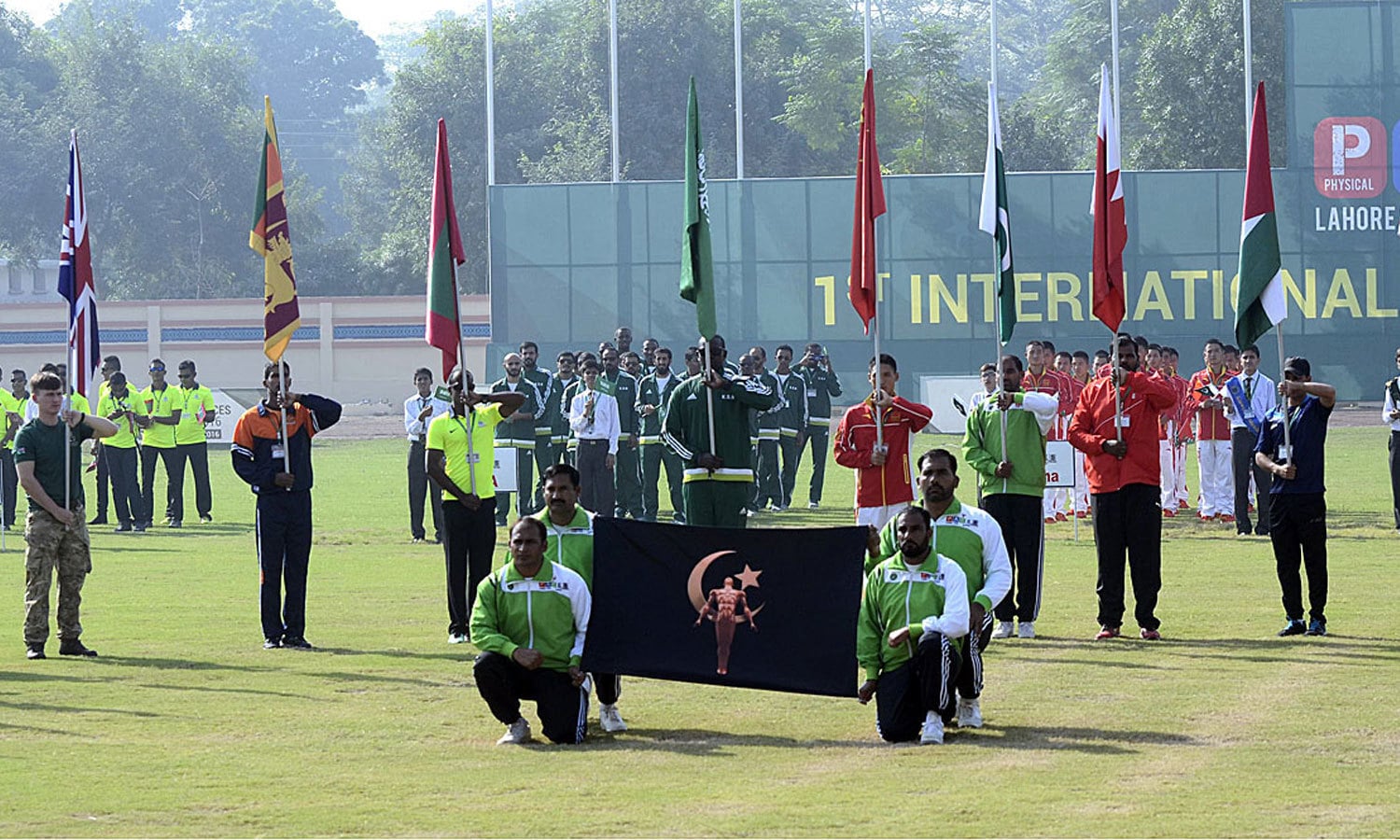LAHORE: Armed forces of at least 136 countries, including Pakistan, not only meet in battlegrounds, but also interact in sports arenas to promote goodwill and display their positive image, besides providing the incentive of physical fitness to their men through these competitive outdoor activities, an exclusive research conducted by the “Jang Group and Geo Television Network” reveals.
In 1919, soon after the First World War (1914-1918), some 18 nations representing five continents had participated in the Inter-Allied Games, which were held in Paris.
Over 1,500 athletes had then competed in 24 different sports in front of a large crowd.
In February 1948, the International Military Sports Council (IMSC) or the Conseil International du Sport Militaire (CISM) was established by five founding nations –Belgium, Denmark, France, Luxembourg and the Netherlands.

Pakistan had joined the CISM in 1952, along with the likes of Iraq, Lebanon and Syria.
It is the second largest multi-sport discipline organization after the International Olympic Committee, holding more than 20 competitions annually.
The CISM today organizes various sporting events, including the Military World Games and World Military Championships for the armed forces of 136 member countries
The sports include Basketball, Bowling, Boxing, Cross country running, Cycling, Golf, Judo, Lifesaving, Marathon, Modern Pentathlon, Orienteering, Parachuting, Rugby Football, Sailing, Shooting, Skiing, Soccer, Softball, Swimming, Tae Kwon Do, Track and Field, Triathlon, Volleyball, Beach Volleyball and Wrestling etc.
Pakistan Armed Forces and sports:
Let us briefly look at the Pakistan Armed Forces and their national and international contributions/achievements in sports like Cricket, Athletics, Swimming, Gymnastics, Kabbadi, Football, mountaineering and Hockey etc:
The younger generation in Pakistan might not know that the Combined Services Pakistan Cricket team had competed in Pakistan's first-class tournaments between 1953-54 and 1978-79.
In 1953-54, this team had trampled all over the Karachi Eleven, with Mohammad Ghazali scoring 160.
In its second match, the Combined Services Pakistan Cricket team had piled up a total of 405 runs against Bahawalpur.
The Combined Services Pakistan Cricket team then toured India and Ceylon (later known as Sri Lanka), where it managed to defeat the Ceylon Cricket Association. This team then played a match against the touring Indians in 1954-55, losing by an innings.
According to Army history, the Combined Services Pakistan Cricket team was more successful in that season's Quaid-i-Azam Trophy, reaching the final, where they lost by nine wickets to Karachi, for whom the Mohammad brothers (Wazir, Hanif and Raees) all scored centuries.
They drew a match against the touring Marylebone Cricket Club (MCC) in 1955-56, with Test Cricketer Colonel Shujauddin making 147 and taking 6 wickets for 71.
In 1956-57, this team defeated East Pakistan Greens in Dhaka as Miran Buksh hunted 6 scalps for 15.
East Pakistan Greens were bundled out for just 33.
However, the Combined Services team was beaten by the Punjab team, with Fazal Mahmood taking 6 wickets for 33 and 9 for 43.
The great Fazal also top scored with 91.
During the 1961-62 Quaid-e-Azam Trophy competition, the Armed Forces team lost to Rawalpindi in a low-scoring match despite the efforts of Shujauddin, who took 4 for 31 and 6 for 69 and made 68 (Combined Services' top score) and 31 (second-top score).
But they won their next four matches and reached the final again. Batting first against Karachi Blues, Imtiaz Ahmed and Shujauddin put on 269 for the first wicket, with Imtiaz going on to score 251.
After taking a first-innings lead Combined Services were dismissed for 143, and Karachi Blues were able to score the 217 required for victory for the loss of six wickets.
It was Combined Services' third and last appearance in a final. Shujauddin was the most successful bowler in the Quaid-i-Azam Trophy in 1961-62, taking 48 wickets at an average of 11.14.
Between December 1964 and February 1977 Combined Services played no first-class cricket. They returned in the 1976-77 season, captained by 41-year old Nayyar Hussain to play in the BCCP Patron’s Trophy.
Overall, the Combined Services played 33 matches in various first-class tournaments, winning 14, losing 11 and drawing 8. They played three other first-class matches, winning 1, losing 1 and drawing 1. They also played a match in India in 1954-55 in a combined team with Bahawalpur, losing to Bombay.
The fantastic wicket-keeper batsman Imtiaz Ahmed, who played 41 Test matches for Pakistan, had also represented Combined Services in 26 fixtures, captaining the team in most of these matches, scoring 1,864 runs.
Colonel Shujauddin played 19 Tests for Pakistan and participated in 27 matches for Combined Services, scoring 1,407 runs and taking 122 wickets.
Other Combined Services players who played Test cricket in the 1950s and early 1960s included Abdul Hafeez Kardar (the first captain of both the Pakistan Test team and Combined Services), Waqar Hasan, Mohammed Ghazali, Miran Bux and Munir Malik. The only Combined Services player from the 1970s who played Test cricket was Naushad Ali.
All the Pakistan Army’s best players and athletes were first discovered and later attained their high standard in these meets; thanks largely to the interest taken in them by the Army Sports Control Board under Brigadier C.H.B. Rodham.
Army athletes hold all the National records and improve on them every year.
Of the existing Asian athletic records, Pakistan holds seven, as against Japan’s six and India’s five.
And of the seven records held by Pakistan, six are held by the Army athletes. Subedar Muhammad Iqbal and Jemadar Jalal Khan have held the British Commonwealth and Empire records for the Hammer-throw and Javelin-throw respectively.
In 1958, over 50,000 spectators at London's White City Stadium had stood up from their seats to applaud Pakistan Army’s Subedar Iqbal for three minutes for his record-breaking throw in a friendly competition.
In 1960, Army’s Muhammad Nawaz broke the British Commonwealth and Empire record for the Javelin-throw at the same stadium during the British Athletic Associations Championship. Of the 12 athletes selected to take part in the Olympic Games in 1960, 11 were part of the Pakistan Army.
Pakistan Army’s contribution towards hockey can be gauged from the fact that the team that won the World Championship in hockey in the 1960 Olympics in Rome, comprised of eight Army players including the captain of the Pakistani team, Major A. Hamid.
Coming to Boxing, of the five boxers who had represented the Pakistani team in the 1958 Tokyo Asian Games, four had belonged to Army; and three of these four had won medals.
Similarly, the four boxers who represented Pakistan in the 1960 Rome Olympics were all soldiers; three were serving and one was ex-serviceman.
Pakistan Army does not lag behind in swimming either. The 7-men National swimming team that participated in the 1958 Tokyo Asian Games were all soldiers.
Remember, as archives show, Army sports teams from different countries had arrived at Lahore in October 2016 to take part in the first ever Physical Agility Combat Efficiency System competition, which was hosted by Pakistan Army.
Teams from Sri Lanka, England, Saudi Arabia, China and Australia had participated in this competition.
Indian Armed Forces and sports:
In India, the Army Sports Institute imparts training in seven sports: Archery, Athletics, Boxing, Diving, Wrestling, Fencing and Weightlifting etc.
Established in 2001 and located at Pune, this institute employs internationally renowned foreign and Indian coaches, qualified physical trainers, a team of specialists in sports medicine, sports physiology, sports psychology, bio-mechanics and nutrition.
The Indian Army Sports Institute provides state of the art training infrastructure, equipment, accommodation, environment and Sports Sciences Centre.
The British Army and sports:
The 99-year old British Army Sport Control Board regulates the sports played in the British Army at all levels. It is funded by both public and non-public funds
The British Army Sports Control Board has a charitable fund and is the principal grant-making body for games played by country’s Armed Forces.
It also authorizes and monitors overseas sport tours and visits across the Army - there are more than 150 tours or visits in an average year, to over 30 countries. The British Army takes part in and hosts many public events throughout the year, from musical spectaculars to displays of some of the most up to date equipment in use today by armed forces around the world.
British soldiers take part in many sports including Athletes, hockey, Football, Rugby, Shooting, Ice Hockey, Cycling, Motorsport, Ice Hockey, Boxing, Judo, Canoeing, Lawn Tennis, Martial Arts, Sailing, Squash, Basketball, Rowing, Fencing, Badminton, Tug of War, Netball and Golf.
The British Army Sport Control Board manages 45 separate sports associations and unions, each of which operates under its own charter.
The overseas tours or visits are undertaken by an individual or by unit, corps and Army teams.
Of late, the British Armed Forces have competed in Holland, France, Morocco, Antarctica, USA, Egypt, Portugal, Brazil, South Africa, Barbados, Canada, Philippines, Hong Kong, Sri Lanka and Spain.
The United States Armed Forces and sports:
The American Armed Forces take part in sports like Basketball, Bowling, Cycling, Golf, Judo, Marathon, Modern Pentathlon, Parachuting, Rugby, Sailing, Skiing, Soccer, Softball, Swimming, Tae Kwan Do, Volleyball and Wrestling etc.
The United States Armed Forces Sports Programme offers 25 men and women team and individual sports.
It annually conducts 16 Armed Forces Sports Championships and nine qualifying events/trial camps.
It participates in nine US national championships and 16 Military World Championships. In 2016, some 19 American Armed Forces’ members had participated in the Rio Olympic Games and two at the Rio Paralympic Games.
The selection of the United States delegation for national and international events occurs at the annual Armed Forces Championship or through a qualification process such as a trial camp.
There are approximately 20 World Military World Championships conducted each year with the United States delegation competing with 300 athletes in nearly 16 events annually.
JUI-F filed a petition through advocate Kamran Murtaza
New data from 187 countries shows that the estimated number of deaths from viral hepatitis increased from 1.1 million...
APTMA also drew the attention of the finance minister toward high taxes and persistent delays in refunds have squeezed...
The guard appeared at the Westminster Magistrates Court on Wednesday afternoon with his lawyer Moeen Khan
Ogra determines the natural gas tariff for domestic sector consumers and LNG price separately for power sector
The chief minister directed prompt completion of the Lahore Ring Road SL-3 project and urged immediate action







